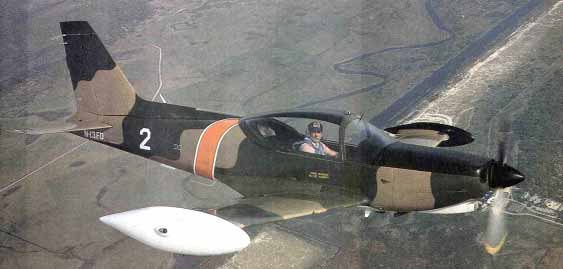PAGE FOUR
 |
How do you improve on lines
like that? |
AFTER DELVING INTO THE AIRPLANE'S STALL characteristics, I was eager
to attempt some landings, since that's where the differences
show up the most. My eagerness in landing the airplane had to be tempered
by figuring out how to get down from altitude and still keep it slow.
The SF.260 is undoubtedly one of the slipperiest little
machines ever built and once going fast, the SF.260 does not like to
slow down. You can get down to 150 knots indicated with no problem
but getting from there to the ridiculously low gear speed
of 108 knots is a real chore when flying a normal pattern. You can
put 15 degrees of flaps out at 125 knots which is a great help, and
by that time you've already worked more than you would normally have
to in most airplanes. This explains why many SF.260 pilots prefer to
fly a military style break, letting the G force slow the airplane down.
That's my only serious complaint about the airplane . . . the gear
speed is just too damned low and it is extremely easy to overspeed
with the gear down until you get a lot of flap out. My last landing
in Sterbutzel's plane was flown out of a formation break from 200 feet
and 200 knots. With Harry on my left wing I brought the power back
and tugged up in a tight right bank and watched as the speed slowed
very nicely to 100 knots, while I threw everything out. That's the
way the airplane is supposed to be flown. It responds to a firmer hand
and a more aggressive style of flying.
Once trimmed to 90 knots, the airplane holds it fairly well, especially
once you have at least 30 degrees of flap down. Full flap extension
is 45 degrees, and at that extension it's necessary to keep the nose
well down to maintain 90 knots. With everything hanging out, you can
drop the nose an acceptable amount and not have the speed climb nearly
as much as you would expect, allowing you to come in at a relatively
high approach angle and lose altitude much faster than most single-engine
airplanes in the civilian inventory.
On my first landing in Florida, I wanted to land the C like an A model
. . . I wanted to establish an attitude and fly it on Navy style with
no attempt to hold off on a full stall landing. Because of the A model's
unpredictable nature at full stall, it's not a good idea to get that
slow—if there's any wind working on you—as the A will unload
and bite you. In Florida, Mike Moore talked me into holding the C off
like a normal airplane and that worked just fine. Later, back home,
flying Sterbutzel's plane, I shot a bunch of landings and found it
handles exactly like a normal airplane. The difference between the
C and A model in that respect was much more than I would have believed,
although I do think the 90-knot approach speed being used was too fast,
especially for a 2,000 ft strip.
The C is probably a much better airplane than the A. It's an
easier airplane to fly and land, probably a better trainer. Some purists
are still going to say that they like the A model for its pure macho
appeal and I very much agree with them. Probably the best of all worlds
would be an A model wing with C model ailerons.
The modifications brought about from the As, Bs and Cs include the
aileron mod and a new fuel system that transfers the tip fuel intothe
main tanks and then into the engine. In the original system it was
always exciting to forget and run a tip tank dry and hope the engine
would catch again. The later aircraft have a taller fin and rudder.
I couldn't feel the difference but I probably didn't fly
it hard enough to find out. Having that extra fin and rudder undoubtedly
helps out in weapon delivery, something I didn't plan on doing much
of in New Jersey.
One aspect of the SF.260 which has never been changed and needs attention
badly are the altitude limitations of its normally aspirated engine.
With an airframe that clean, it is sad that the airplane is not turbocharged,
since the SF.260 runs on a manifold pressure of 7,500 feet. The cowl
is extremely tight and doesn't have a heck of a lot of extra room for
a blower, stories are circulating that someone in the West is working
on a dual Rayjay blower installation, which would make the SF.260 one
fast mother at altitude. There would be no reason that airplane
couldn't run 225 mph at cruise or better at 10,000 to 12,000 feet.
In the past, the mechanical support of the airplane has been subject
of many horror stories. Now, with Fox Five One in action and nearly
twenty airplanes in the States, the picture should be changing.
Like I said, the SF.260 is not an airplane for everybody, which is
just as well because at the price tag of close to $200,000 not everybody
can afford it. Used aircraft seem to run in the $80,000 to $140,000
category, which is still a long ways from being everyman's
price tag. Personally I am keeping my eyes open for a well-used hulk
sitting somewhere at the edge of a desert airstrip in the boondocks
of a Third World country whose mechanics couldn't figure out how to
change the spark plugs. I have visions of offering them $5,000 in dollar
bills and having them ship it home to my place via UPS. On the other
hand, I may just creep on over into Shepard's airplane and let him
pick up the tab.
GO TO NEXT PAGE
|

